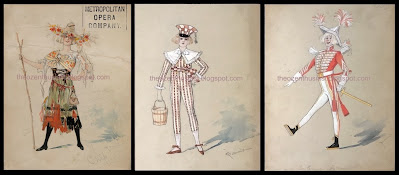As a collector, I find it's the unexpected discoveries that tend to be the most memorable. Last month I stumbled across a listing in an upcoming auction that caught my eye. It was a group of 11 costume designs by Caroline Siedle, the designer of many Broadway shows at the turn of the last century. The auction was scheduled for the next day, so I quickly registered for a chance to bid on this set of drawings, hoping to add it to my collection. At a glance there was an interesting variety of pieces, and designs by Siedle don't turn up very often; so I was happy to see them.
Caroline Siedle died unexpectedly in 1907, but from about 1895 until that time she was in great demand as a designer for the many shows being produced on Broadway. She was known for her skill in harmonizing the colors of costumes to blend with the scheme of the overall set design, creating a fully developed stage picture. She was also the first female costume designer to be regularly credited in theater programs for her work. Two standouts among the dozens of productions she worked on were The Wizard of Oz and Babes in Toyland, both produced in 1903.

"Yes; mad through with blighted love. Now will I to the vegetable garden where I last saw him.
(Taking objects from basket on arm.)
Here are young spring onions - they're for insomnia; here's celery for remembrance,
- and here are March strawberries - for -- a dollar a box!
"Oh, he never more will come,
And I wonder where he's went.
Hey nonney, hey nonney hey!"
(Exit a la Ophelia, L.I.)
The photo on the left shows Allene Crater wearing the finished costume. It's not surprising that the auction house failed to call out the significance of this piece - how many people have ever heard of Cynthia Cynch? The character doesn't appear in any version of The Wizard of Oz other than the 1903 musical. Of course this fired my determination to acquire the group of drawings, and I was quite happy when I won the lot with minimal competition. (I should mention the presence of the stamp from the Metropolitan Opera, which simply throws confusion on the piece. Siedle's husband Edward was the highly regarded prop-master and technical director at the Met, and I believe that after her early death (or even before) many of her drawings were archived there. It's not uncommon to see the stamp on her work, even when it was clearly not designed for the opera house.)
After the auction was over I studied the group of images again, because now this one was nagging at the back of my mind. There was a caption at the bottom of the drawing, that I couldn't quite decipher in the auction house photo - until it suddenly clicked and I read "Lady Lunatic Act 2". Here was a second act design for the same character, making it two Oz drawings in the group of 11!
I had been able to recognize the Act 1 drawing from familiarity with several photos of the character in costume; but the only second act photo I've seen of Cynthia shows a significantly different outfit (worn on the left by Helen Byron). However, the design is clearly labeled and the repeating pattern of hearts together with the green & white color scheme certainly is appropriate for the character in the Emerald City. When I eventually received the drawings and could look at the back of each piece, this was clinched even further. The upper left corner of the first act design is labeled "Byron", meaning Helen Byron who originated the role on Broadway. On the back of the second act drawing was printed "Miss Crater"; Allene Crater took over the role of Cynthia in 1903, and played the character for several years, during which time she married Fred Stone, the original Scarecrow.
She was with the company when it returned to Broadway in 1904 as the "Edition de Luxe" version of the show. This production included a number of new songs, and - some redesigned costumes. I believe this may be one of the new designs. For more info, check out David Maxine's Vintage Broadway blog where he discusses another redesigned costume.
The backs also have handwritten notes concerning fabric choices, and details about the construction of the costumes; always a fascinating insight into the process of putting a show together. The Act 1 costume describes a necklace of red peppers for the character, and floats the idea of using fresh peppers. On the Act 2 design, attention is called to the “gloves to wrist with long turned up tips to fingers”. It’s fun to ponder whether these particular suggestions were carried out!
These are the first drawings I've run across in the wild of a main character from the show. The Shubert Archive in New York City holds the majority of designs that survive from the production, including the third act costume design for Cynthia. So, here's a reunion of the three drawings!



























